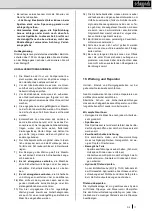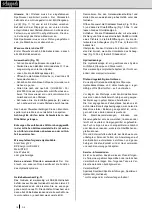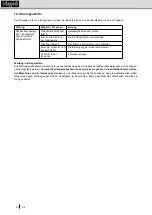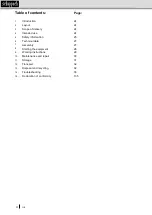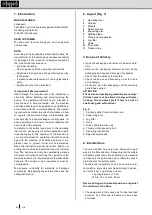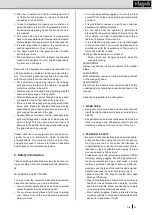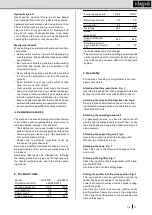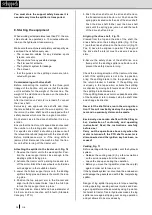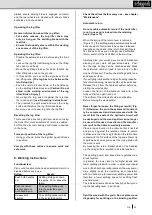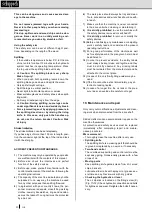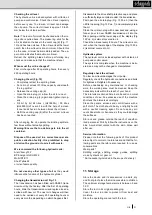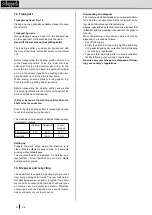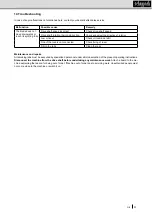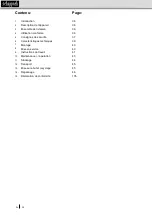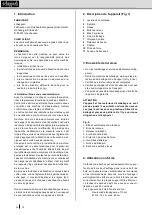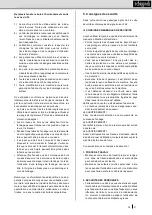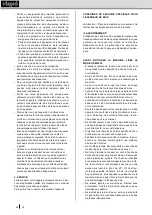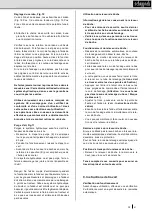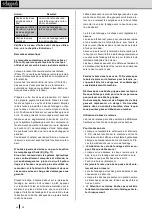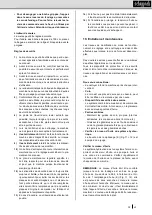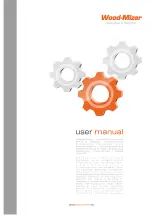
30
GB
This can be dangerous and cause severe dam-
age to the machine.
Do not remove jammed logs with your hands.
Never let other people help you when removing
jammed logs.
Piled up, split wood and wood chips can be dan-
gerous. Never work in an untidy working envi-
ronment where you can slip, stumble or fall.
Using the safety arm
The safety arm can be set at different height posi
-
tions, depending on the length of the wood.
Splitting
•
If the outside temperature is below 5°C, let the ma
-
chine run idle for about 15 minutes so the hydraulic
system reaches its operating temperature. Place
the log under the splitting blade vertically.
•
m
Caution: The splitting blade is very sharp.
Risk of injury!
•
When you push both operating levers down, the
splitting blade goes down and splits the wood.
•
Only split straight cut logs.
•
Split the logs in vertical position.
•
Never split in horizontal position or across.
•
Wear suitable gloves and safety shoes when split
-
ting wood.
•
Split very misshapen logs from the edge.
•
m
Caution: During splitting, some logs can be
under significant tension and suddenly break.
•
Force jammed logs out by applying pressure in
the splitting direction or by raising the riving
knife. In this case, only push the handles up,
do not use the return bracket. Caution: Risk
of injury
Stroke limitation
The stroke limitation can be set steplessly.
If you have logs of more than 100 cm in length, posi
-
tion the connector right at the top of the rod and lock
it with the star grip.
ACCIDENT PREVENTION STANDARDS
1)
The machine may only be operated by people who
are well familiar with the contents of this manual.
2)
Before use, check the intactness and perfect
function of the safety devices.
3)
Before use, make yourself also familiar with the
control mechanisms of the machine, following the
operating instructions.
4)
The capacity of the machine indicated may not be
surpassed. In no way may the machine be used
for any other purposes than splitting firewood.
5)
In agreement with your country’s laws, the per
-
sonnel must wear adequate, close-fitting working
clothes. Jewelry like watches, rings and necklac
-
es must be taken off. Long hair must be protected
by a hair net.
6)
The work place should always be tidy and clean.
Tools, accessories and wrenches should lie with
-
in reach.
7)
Make sure that the machine is never connected
to the drive unit when cleaning or maintaining it.
8)
It is strictly prohibited
to use the machine with
the safety devices removed or switched off.
9)
It is strictly prohibited
to remove or modify the
safety devices.
10)
Before undertaking any maintenance or adjusting
work, carefully read and understand the present
operating instructions.
11)
For a good performance of the machine as well
as for safety reasons, the plan given herein must
be adhered to.
12)
In order to prevent accidents, the safety labels
must always be kept clean and legible, and they
must be strictly observed. Any missing labels
must be reordered from the manufacturer and be
attached to the correct place.
13)
In case of fire, only fire-fighting powder may be
used.
14)
If the fire cannot be extinct immediately, pay at
-
tention to leaking liquids.
15)
In case of a longer fire, the oil tank or the pres
-
sure lines can explode. Be careful not to get
10. Maintenance and repair
Only carry out modifications, adjustments and clean
-
ing work when disconnected from the drive shaft.
Skilled craftsmen can execute smaller repairs on the
machine themselves.
All protection and safety devices must be replaced
immediately after completing repair and mainte
-
nance procedures.
We recommend:
• Thoroughly clean the machine after every use.
•
Splitting knife
The splitting knife is a wearing part that should be
reground or replaced by a new one, if necessary.
•
Two-hand control
The combined supporting and control unit must be
kept easy-going. Occasionally grease with a few
drops of oil.
•
Moving parts
Keep splitting knife guides clean from dirt, wood
chips, bark etc.
Lubricate slider rails with spray oil or grease sev
-
eral times a day. Never work with dry guides.
•
Checking the hydraulic oil level
The oil dipstick is located on the filling screw (K)
(Fig. 11+12). Check hydraulic connections and bolts
for tightness and wear. Retighten the bolts if neces
-
sary.
Summary of Contents for 5905501903
Page 2: ...2 Fig 1 1 2 3 4 5 6 7 8 9 10 11 1 7...
Page 3: ...3 1 2 3 4 6 5 8 7 Fig 2 2 M22 A 1 3 2 Fig 3 B 2 M10 2 M22 A 2 4 Fig 4...
Page 6: ...6 Fig 12 max min 1 3 2 Fig 13 1 3 2 Fig 14 Fig 15...
Page 7: ...7 Fig 16 Fig 17 Fig 18 Fig 19...
Page 21: ...21...
Page 47: ...47...
Page 61: ...61...
Page 134: ...134 HL1800G HL2500G...


